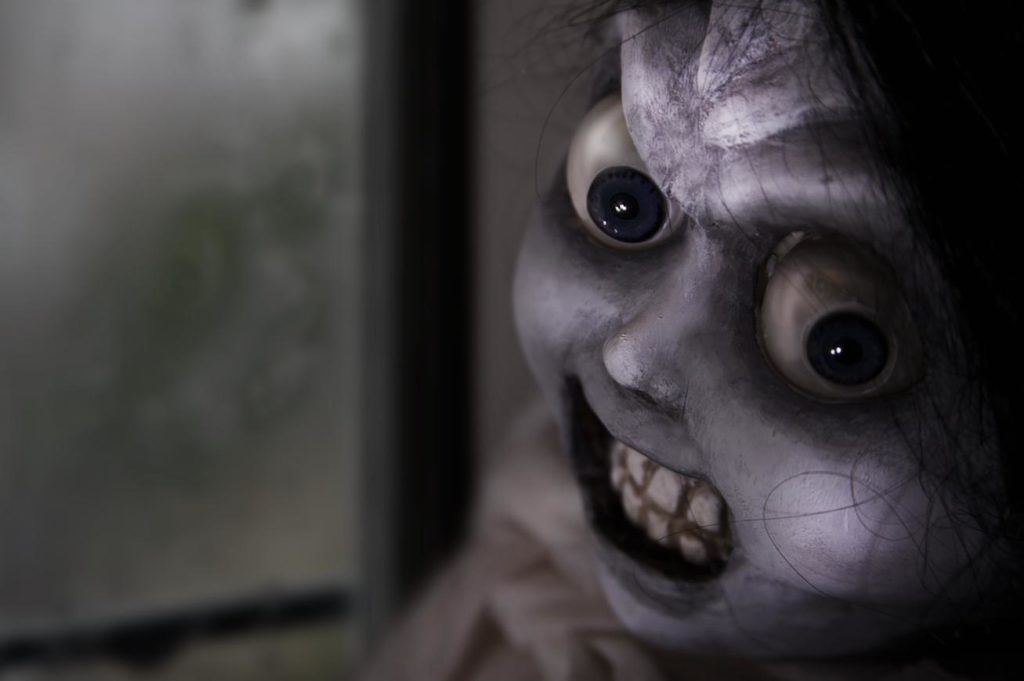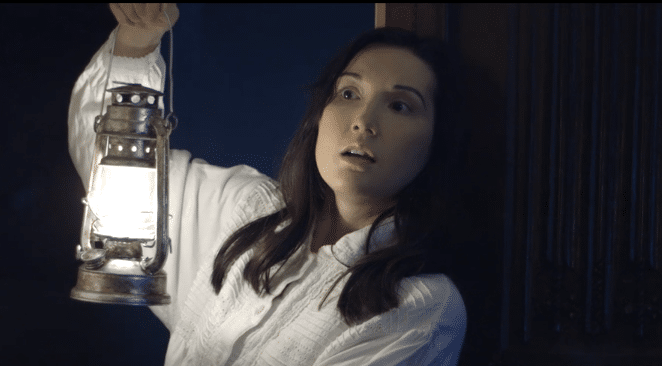 I try to make it a point never to openly roast films just for the fun of it; whatever I say about a project, I try to ask myself whether I’d be happy to say it in front of the filmmaker themselves, and I try really hard to remember that real people out there might have poured a lot of effort into their movie. So, with that in mind, I did try to stick to this with regards The Curse of the Witch’s Doll (2017), and not only because I was the one who chose to watch this screener – I made the decision. So all told, in this case I would definitely say these things in front of the people responsible for this film, and it turns out to be physically impossible to talk about it without an air of exasperation bordering on a good roast. To do otherwise would be worse than dishonest. Alright, so let’s get on with it.
I try to make it a point never to openly roast films just for the fun of it; whatever I say about a project, I try to ask myself whether I’d be happy to say it in front of the filmmaker themselves, and I try really hard to remember that real people out there might have poured a lot of effort into their movie. So, with that in mind, I did try to stick to this with regards The Curse of the Witch’s Doll (2017), and not only because I was the one who chose to watch this screener – I made the decision. So all told, in this case I would definitely say these things in front of the people responsible for this film, and it turns out to be physically impossible to talk about it without an air of exasperation bordering on a good roast. To do otherwise would be worse than dishonest. Alright, so let’s get on with it.
We begin in England, 1660 – just in time to see a witch being dragged off to her demise, though having a quick word with a carved wooden doll just beforehand. Okay, this is the first place where I have to pause in disbelief. WHAT THE FUCK IS THAT THING? (Spoiler alert: that’s not the same doll used on the cover art.)
Although surviving dolls from that period are few in number, those that we do still have are fairly benign-looking, with ladylike faces and intricate costumes. The doll in this film looks like a cross between a Japanese Oni and something from Charles Band’s bin. Immediately the film looks to be heading in a Charles Band sort of direction, playing for laughs. We’re in trouble if it doesn’t, thought I, because it is entirely impossible to take this wild-eyed bauble at all seriously. No wonder the witch says she will “never forget”. Nor will I.
We then dart forward in time to 1942 – this film is nothing if not a tale for the ages – where Mrs Aveline Gray (Helen Crevel) and her perpetually-annoyed daughter Chloe (Layla Watts) are moving into a new, countryside home to escape World War II bombs. Erm, Chloe? A rare enough name for a child born in the late 1930s, but okay – she might be one of the few. Perhaps more surprising is that a lone mother and daughter could afford to move into what looks like a manor house, or how they happened upon it, but in any case, the landlord (Philip Ridout) shows them around. He must be competent at his job, in any case, as he manages to lease the property to them, despite that 17th Century doll being sat at the window. Perhaps it’s a forerunner to the Ebay mentality, where people seem able to shift any old tat by saying it’s ‘haunted’. Or, perhaps he simply hasn’t noticed it, which would be strange for a landlord.
Well, Chloe takes a shine to the doll soon enough; it doesn’t stop her from hating their new home and pining for her missing soldier father however, and soon Adeline is getting spooked by the new place. She wants to leave, but Arthur dissuades her, reminding her that yet another move would be disadvantageous for her and Chloe. But then little Chloe goes missing in the woods, and a creepy disembodied voice tells Adeline that “the witch has her”. Adeline pleads with the local authorities to help her find her daughter, but weeks begin to pass and so she starts exploring the house – belatedly looking for some sort of clues as to Chloe’s whereabouts. Letters which she finds hidden in the house begin to show her that all is not as it seems. In fact, is this the real life? Is this just fantasy?
 A missing child is meant to be a cataclysmic event in a person’s life, but no one in this film seems massively bothered. To be fair, I feel that the cast are making an effort with what they’ve been given, but they come across as self-conscious, and certainly not expressive of any great concern – not the mother, not the detectives who pop in once or twice and do little else, and not the landlord either. You could possibly argue that as ‘things aren’t what they seem’ (yes, the film attempts THAT plot twist) then this is reflected in the performances, but actually I don’t think so – I’m not prepared to do the work here to justify what I’ve watched. Add to this a script rammed with stock phrases like “we’re doing all we can” and a bewildering array of lighting and sound problems, and it’s devilishly hard to suspend your disbelief. Additional attempts to add dramatic interest by changing tack invariably fall flat, because it’s not possible to believe in anything up until the point of the plot shift anyway.
A missing child is meant to be a cataclysmic event in a person’s life, but no one in this film seems massively bothered. To be fair, I feel that the cast are making an effort with what they’ve been given, but they come across as self-conscious, and certainly not expressive of any great concern – not the mother, not the detectives who pop in once or twice and do little else, and not the landlord either. You could possibly argue that as ‘things aren’t what they seem’ (yes, the film attempts THAT plot twist) then this is reflected in the performances, but actually I don’t think so – I’m not prepared to do the work here to justify what I’ve watched. Add to this a script rammed with stock phrases like “we’re doing all we can” and a bewildering array of lighting and sound problems, and it’s devilishly hard to suspend your disbelief. Additional attempts to add dramatic interest by changing tack invariably fall flat, because it’s not possible to believe in anything up until the point of the plot shift anyway.
Coming back to this issue with the suspension of disbelief, the plausibility of this film being set in the 1940s is pretty ropey from the first. It’s very difficult to create a viable period setting, and giving the lead actress victory rolls just isn’t enough. I’ve already alluded to the name issue; other characters sport buzzcut hairdos or other anachronisms, and the overall impression here is of someone who’s seen The Others and Shutter Island and thought they’d have a go at blending the two together. Then, there are other issues: the cliché door slamming, the obligatory husky-voiced supernatural forces and then the cavalier laughter of same, the obligatory ‘demon’ make-up which always looks identical, the endless flat-voiced talking, Crevel’s worsening mental state being represented to us by clumsy eye-bags being added in make-up… And then having the nerve to jump forward to yet another point in time, just to rub salt onto the death by a thousand cuts.
As a very young filmmaker is responsible for this film, I can only hope that The Curse of the Witch’s Doll is just the beginning of the road and that one day an older, wiser man will seek to bury it without trace. This simply isn’t good enough by any single measure I can think of, as a film fan who tends towards the forgiving. It’s thin, derivative and predictable throughout, it lacks research, budget or cogent ideas and the only thing it does well is show that making a good horror film isn’t as easy as some would have us believe.
The Curse of the Witch’s Doll is available on VOD from 6th February 2018.
